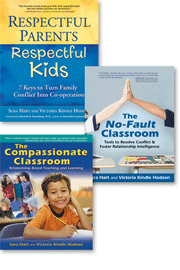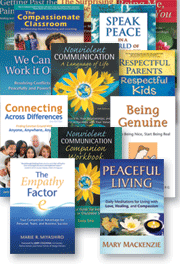Create Compassionate Schools... continued
I began to wonder how this gets thwarted in so many of us at such early ages. And I began to search for how I could contribute to a world that doesn't get in the way, one that nurtures children's curiosity and eagerness to learn. I began to look closely at schooling.
By the time I met NVC, I had been working in alternative schools for eight years and was teaching at a private school in Ojai, California, founded by the Indian philosopher, J Krishnamurti. The ethos of the school was about caring for the wholeness of each child and the whole of life.
The classrooms were small, gently guided by passionate teachers, and surrounded by acres of beautiful oak-studded hills. The curriculum integrated the natural world, music, drama, and intercultural experiences. It was, for me, an ideal school for me, and for my daughters.
The beauty of the school campus and curriculum did not, however, solve the challenges of how to live our values day to day so we could be the model of change we wanted to see in our students. To address this challenge we teachers spent hours in weekly staff meetings puzzling over the day to day challenges of managing a classroom, keeping kids safe, inspiring willing cooperation, fostering discipline without punishment, and cultivating a culture of genuine care among students, teachers and parents.
When I met NVC, I instantly recognized it offered the practical tools and daily practice I needed, to create the school of my dreams.
Over the next 24 years, I worked with Marshall Rosenberg and other NVC practitioners to support compassionate classrooms founded on NVC consciousness and practices; I served as director of CNVC's Education Project; coauthored three books (two for teachers, one for parents) with Victoria Kindle Hodson; cofounded the 5-day NVC Educators Institute; and worked with hundreds of teachers and school administrators.
With the hope that some of what I've observed and learned to this point could be useful to others, I share here a few brief reflections on four topics related to NVC and schools.
- How we can effectively address bullying behavior in schools
- Some pitfalls in "Taking NVC to Schools"
- Why I promote a systemic approach to school change
- What a "school wedge strategy" can do, on the way to transformative change
How we can effectively address bullying behavior in schools.
There are increasing reports of bullying in schools. According to the National Center for Education Statistics, in 2007 nearly a third of all students aged 12 - 18 reported having been bullied at school, some almost daily. (BullyingStatistics.org)
The movie, Bully, has helped put a national spotlight on bullying and, I hope, will result in more focused and sustained efforts to promote the social-emotional wellbeing of students.
At the same time, I'm incredibly sad to see the narrow and misguided framework of most of the "anti-bullying" programs in schools. In so many of these programs, students are labeled, isolated, and stigmatized for acting out their pain in ways they have learned so well from the world around them -- from mainstream media and from adult modeling throughout what I see as a "bullying culture. "
While I've been following the movement "against bullying", what interests me much more is the growing movement towards activating empathy in schools. I find this more engaging because I believe programs that foster empathy and other social-emotional skills, are the best antidotes and remedies for bullying in schools, and elsewhere. (Bullying does not happen only in schools. There are reports that 35% of the workforce reports being bullied at work. WorkplaceBullying.org)
They need, instead, to cultivate a climate of safety, trust, and respect, and address behavior and especially "behavior problems" with intent to understand what's at the root of bullying behavior— what needs the students are attempting to meet when they act out in "bullying ways" and how to effectively address these needs. If adults do not seek to understand troubled youth, the kids get more troubled and the troubles for everyone get bigger.
The good news is that there are growing numbers of SEL (social emotional learning) programs in schools. The ones that hold promise for systemic change in the bullying cultural in our schools are those that focus on building a social climate that fosters safety, trust and caring, and that knows better ways to promote self-responsibility and self-discipline than using punishment and rewards.
(If you'd like to put some of these same principles into use at home, please sign up for our free worksheet, Bully Proof Your Home. It's available free from our website: TheNoFaultZone.com)
I'm excited to see more and more of these SEL programs powered by NVC consciousness and skill-building. At the same time, I have seen many roadblocks and pitfalls in "taking NVC to schools" and I'd like to point out a few of these.
Some Common Roadblocks and Pitfalls in
"Taking NVC to Schools"
Over the years, I've seen many people, many parents, passionate about taking NVC into schools, encounter one or more of the following roadblocks to bringing a program in and pitfalls encountered while trying to implement a program. I hope that by naming them, it will inform current and future efforts.
-
A systemic hierarchy and embedded philosophy in most schools, including beliefs in authoritarian teaching practices, involving a system of rewards and punishment
-
Short attention span and many competing priorities in schools
-
Frequent personnel changes in schools often result in loss of original NVC champions
-
Alarm & resistance from a few or many teachers, administrators, parents, when they are asked, up front, to change their paradigm and the way they've learned to interact with young people
-
Fear on the part of many that meeting children with empathy means permissiveness
-
Sequential training programs for adults take a long time, and more resources than many school are able to provide or have commitment to follow through with
-
When the teacher (or volunteer) does not embody the principles of NVC, then "teaching kids NVC" is just another variation of "this is what you should learn and do, so you can be a better person."
-
The idea of "taking NVC to schools" means many things to many people, and sometimes takes the form and spirit of a crusade, which, inevitably, stimulates resistance
While I have watched many passionate parents take their big and urgent dreams to schools, and then come to full stop in the face of formidable roadblocks and stumble in these pitfalls, I have seen others take what seem like small steps, that later grow into school-wide change.
Success in all cases is built upon relationships that begin with empathic connection with a teacher, administrator, counselor, or parent. Once there is connection around shared vision and goals, it helps if parents have some understanding of the time it can take for school-wide change to happen, and a readiness to offer something they can do now -- what I describe as "school wedge strategies" below -- to support your shared big vision now.
Why I Promote a Systemic Approach to School Change
Schools are complex organizations with layers of decision making, bureaucracy, and, in many U.S. schools, a single-minded focus on testing as a strategy to satisfy the higher-level strategy of meeting state standards.
This focus persists even though it is obvious to many that the strategy of mandatory testing doesn't address -- and even gets in the way of -- the deepest concerns of parents, teachers and students alike, for optimal learning and thriving.
The big challenges so many of us encounter in schools are finding the sustaining support, will, focus, and funding for NVC and other SEL programs in order to build a foundation of safety and trust that effectively supports academic, social, and emotional learning .
A needs-based, systemic approach to school transformation is exciting, but it takes time. It involves more than "teaching NVC communication skills". The most extensive school change project I know about is taking place in a charter school of 1,000 students in Michigan. Victoria Kindle-Hodson has been working closely with that school for six years, with dramatic transformative results throughout the school.
-
Systemic change takes time.
-
It often starts as a grassroots movement
-
Each school is different and requires a unique and collaborative approach.
-
It can start anywhere and often begins with a small move, always with one conversation, then another...
-
It's all about relationships and collaboration.
-
It's also about patience and perseverance.
-
School "wedge" strategies are often necessary to get in the door.
How Can a "School Wedge Strategy" Help?
Because school change takes time, it can be helpful to have a "school wedge strategy, something to get in the door, that a teacher or counselor or parents can start using, before there is school-wide buy-in.
The No-Fault Zone Game that I co-created with Victoria Kindle-Hodson, is an example of a "school wedge strategy" that contributes to transformative change in school, because of these features:
-
The Game is easy to use for all ages.
-
The Game addresses all learning styles including visual and kinesthetic, which are often overlooked in schools.
-
Young people use it by themselves to get self-connected and sort out their own conflicts. Adults are all for that: it's an easy sell.
-
The Game can be used in any setting from school, to home, to after-school program, to juvenile justice...
-
While it is difficult to get a new program in through the front door of schools, The Game has found its way to classroom teachers, to counselors, to peer mediators, etc. It then spreads from there.
-
The Game complements and strengthens existing programs: Peer Mediation, Social-Emotional, Anti-bullying programs, AND Academics. (It supports state standards.)
-
The Game stimulates interest in further NVC training.
As an example of just how successful a school wedge strategy can be, in Michigan, the No-Fault Zone Game started in elementary classes, spread to secondary, and now it is used in administration. Sophie Langri, a parent in Quebec first brought the Game into her children's school, as a volunteer. A year later she was hired full time to teach The No-Fault Classroom and NVC throughout the school.
Sophie Langri and Tom Gostinger, administrator at the Michigan school are featured on a video panel about how the No-Fault Zone Game activates empathy in Schools, at this link on Edwin Rutsch's "Creating a Culture of Empathy" website:
You can learn more about and purchase The No-Fault Zone Game at our website: TheNoFaultZone.com
Parents can also get a free download from our website about how you can "Bully-proof Your Home." (Read more about this below.)
For those of you who have read to this point, I hope something here has been useful. I would enjoy hearing your comments.
Sura Hart is an internationally recognized trainer with the Center for Nonviolent Communication (CNVC) and is the contact person for projects integrating NVC into U.S. schools. She designs and facilitates trainings and curricula for students, parents, teachers, and school administrators around the globe, and is a co-founder of the annual five-day NVC Institute for Educators: Teach for Life! She is co-designer of The No Fault Zone Game® and co-director of The No-Fault Zone.
PS If you'll be in Seattle, WA on Jul 19, 2012, join Sura from 11 - 1 at the Dispute Resolution Center of King County for our workshop: The No-Fault Zone Game: Strategies to Resolve Conflict
Keep learning these vital
communication skills with these books and training
resources:
This Month's Specials:
- NVC Hart / Hodson Package or eBook Package - Save 60% off list price through July 31, 2012
- Reference Library Book Package or eBook Package - Save 65% off list price through July 31, 2012
Every Day Book
Package Specials:
- NVC Starter Kit Book Package and eBook Package - Save 40%-50% on this book package every day from PuddleDancer Press
- NVC Marshall B. Rosenberg, Ph.D. Book Package and eBook Package - Save 45%-55% on this book package every day from PuddleDancer Press







